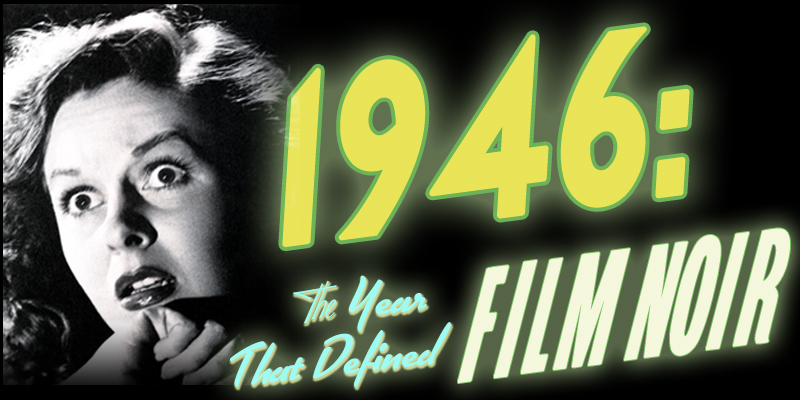
NOIR LINKS
10 Shades Of Noir
Back Alley Noir
Classic Noir Online
Dr. Noir's Crime Posters
AMC Film Noir
Film Noir Foundation
The Dark Room
Noir of the Week
Noircast.net
Film Noir Alley
Noir City
IMDb
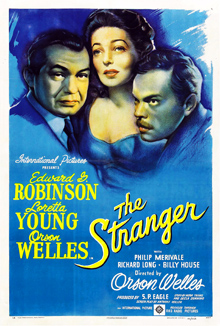 By 1946, film audiences were used to seeing the damage that the horrors of war had wrought on their returning veterans. The Stranger brought the
source of those horrors right into the heart of small-town America.
By 1946, film audiences were used to seeing the damage that the horrors of war had wrought on their returning veterans. The Stranger brought the
source of those horrors right into the heart of small-town America.
In an allusive and atmospheric prologue to the main action of the film, Edward G. Robinson as Allied war commissioner Wilson decrees that accused Nazi
war criminal "Konrad Meineke" be allowed to escape from captivity, in the hopes that he will lead the Commission to their ultimate quarry, Meineke's former superior
Franz Kindler (Orson Welles), an alleged architect of the Final Solution who went missing from eastern Europe in the last months of the war.
Meineke is shadowed on a tramp steamer to an unspecified port in South America - an uncannily accurate allusion to the actual clandestine pipeline
that ferried scores of Nazi criminals to Argentina the post-war years - and then again when Meineke learns of Kindler's whereabouts from a minor functionary
of some putative overseas Nazi underground and re-embarks for the U.S.
Robinson picks up the trail and follows Meineke to Harper, Connecticut, a bucolic New England backwater where Kindler has somehow landed and forged
a new identity as Charles Rankin, a teacher at the local boys academy. This premise, of course, stretches credulity to the breaking point: that a notorious Nazi -
learned and cosmopolitan though he may be - has managed to make his way from the killing fields of eastern Europe to the U.S. in only a few months and
insinuated himself into an esteemed occupation in genteel society, speaking perfect American-accented English all the way.
Suspension of disbelief may be more difficult for modern viewers to accomplish with the benefit of historical hindsight, however. In the post-war
years, rumors of the survival of leading Nazis as prominent as Hitler were common, and fears of a global underground Nazi revival were a relatively
long-lived hangover of war. The Stranger goes about earning its distinction by melding the most sinister elements of contemporary history with
uniquely domestic currents of social anxiety, taking the film noir in a new direction and paving the way for the successor wave of external threat films,
the "Red Menace" anti-communist cinematic jeremiads of the late 1940s and early 1950s.
Situating the remainder of its action within the constricted confines of the small town of Harper, The Stranger immediately gets about injecting
striking images of perversity and disorder within the film's quaint setting, symbolically asserting the intrusion of global forces of violence and barbarism
upon the home front.
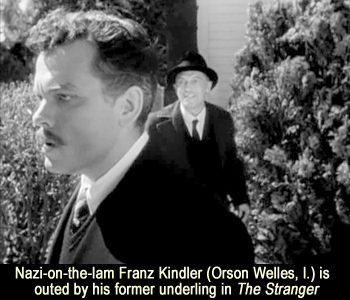 Though it turns out that the former SS killer Meineke has become a hapless, babbling evangelical following a jailhouse repentence and conversion, Kindler
strangles his former henchman in a wooded area and covers up the corpse with leaves and underbrush, all the while dodging some of his students who are
frolicking in the woods. In one of The Stranger's most perverse juxtapositions, Kindler then re-assumes his double identity as Rankin and rushes off
to the town church for his marriage ceremony with Mary Longstreet (Loretta Young), the daughter of a Supreme Court judge.
Though it turns out that the former SS killer Meineke has become a hapless, babbling evangelical following a jailhouse repentence and conversion, Kindler
strangles his former henchman in a wooded area and covers up the corpse with leaves and underbrush, all the while dodging some of his students who are
frolicking in the woods. In one of The Stranger's most perverse juxtapositions, Kindler then re-assumes his double identity as Rankin and rushes off
to the town church for his marriage ceremony with Mary Longstreet (Loretta Young), the daughter of a Supreme Court judge.
As Wilson lingers in Harper, insinuating himself in the lives of the townfolk to learn more about Rankin/Kindler, the fugitive's behaviour becomes more
and more erratic. Rankin raves at a dinner gathering that world peace will never be secured without the complete extermination of every living German, but
slips up and reveals his true Nazi leanings when he declares that Karl Marx was not a German, but a Jew. Rankin/Kindler eventually becomes hopelessly enmeshed
in his own web of lies and deceit, killing his wife's dog when the animal begins sniffing around Meineke's corpse, and making plans to do away with Mary
herself after her father and Wilson confront her with their suspicions about Rankin's true identity.
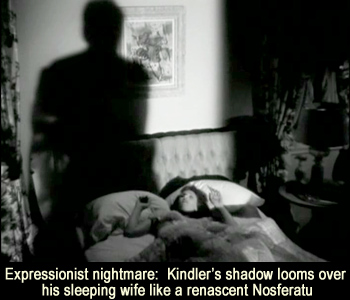 Director Welles offers some striking visual correlatives to the ever-narrowing net around Rankin/Kindler, favoring tight, claustrophobic close-ups, odd, unsettling
camera angles, and a perponderance of shadows around and within the frame. In one particularly evocative image, Welles shoots Rankin/Kindler's looming shadow
falling on the sleeping form of his wife, in a direct nod to the 1922 German Expressionist silent classic Nosferatu, which featured a nearly identical
scene as the vampire crept into the boudoir of his victim.
Director Welles offers some striking visual correlatives to the ever-narrowing net around Rankin/Kindler, favoring tight, claustrophobic close-ups, odd, unsettling
camera angles, and a perponderance of shadows around and within the frame. In one particularly evocative image, Welles shoots Rankin/Kindler's looming shadow
falling on the sleeping form of his wife, in a direct nod to the 1922 German Expressionist silent classic Nosferatu, which featured a nearly identical
scene as the vampire crept into the boudoir of his victim.
If there's a suggestion of order being restored when Kindler plunges to his death from the pinnacle of the town's clock tower at The Stranger's climax,
the film in its entirety leaves an overwhelming impression of dread, menace, and irrationality. These qualities rise to a unique and distinct level of novelty by
being embodied in the person of Kindler, who is the ultimate alienated outsider as a global war criminal masquerading as a harmless teacher in a quiet
American town. It is interesting to speculate on what directions anxieties about covert and resurgent Nazism might have taken the noir film in the remainder of
the 1940s. However, such fears were soon eclipsed by the new strains of dread relating to the inception of the Cold War, and Hollywood refocused anxieties about foreign penetration
on the alleged global Communist conspiracy and related nuclear espionage.
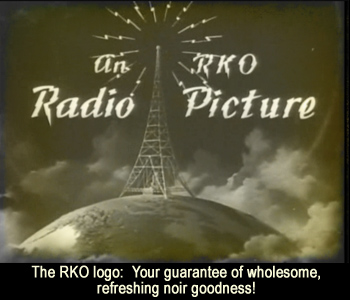 Amongst film noir aficionados, perhaps no studio commands the same kind of respect and esteem as does RKO, owing to the steady stream of gritty and stylish thrillers that
the studio cranked out reliably throughout the 1940s and 1950s.
Amongst film noir aficionados, perhaps no studio commands the same kind of respect and esteem as does RKO, owing to the steady stream of gritty and stylish thrillers that
the studio cranked out reliably throughout the 1940s and 1950s.
At least some of this good fortune can be retrospectively attributed to the perenially cash-strapped studio's practice during the period of maintaining contracts
and working arrangements with entirely independent production groups - an arrangement that garnered RKO such innovative talents as the Val Lewton group that was
responsible for such low-budget but innovative horror classics like Cat People, I Walked With A Zombie, and The Leopard Man, all from 1943.
RKO's constant quest for the one talent or group of talents that would produce the kind of runaway box-office successes that would vault it into the same leagues as its
richer studio counterparts led it in 1939 to strike a deal with Orson Welles' Mercury Theater group. It was a marriage that nearly resulted in absolute financial ruin for
RKO, even if Welles' tenure produced films like Citizen Kane (1941) and The Magnificent Ambersons (1942) that are unreservedly hailed as landmarks in the
history of cinema.
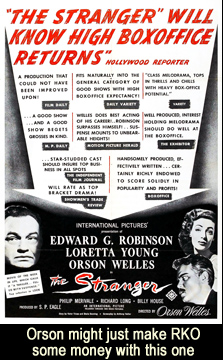 By 1945, Welles was virtually persona non grata at RKO, owing to follies such as his spendthrift South American epic It's All True, shot in Brazil in
1942 but never released. With his stock at an all-time low, Welles agreed to direct and star in The Stranger simply to demonstrate that one of his
film projects could actually be a financial success, a theme given some prominence in the studio's advertising campaign for the film.
By 1945, Welles was virtually persona non grata at RKO, owing to follies such as his spendthrift South American epic It's All True, shot in Brazil in
1942 but never released. With his stock at an all-time low, Welles agreed to direct and star in The Stranger simply to demonstrate that one of his
film projects could actually be a financial success, a theme given some prominence in the studio's advertising campaign for the film.
Though Welles displayed little enthusiasm for the project and insisted in later years that The Stranger was his worst film, it did indeed succeed
where some of his more justly famous films failed. The Stranger has the distinction of being the only one of Orson Welles' films that showed a profit on its first release.